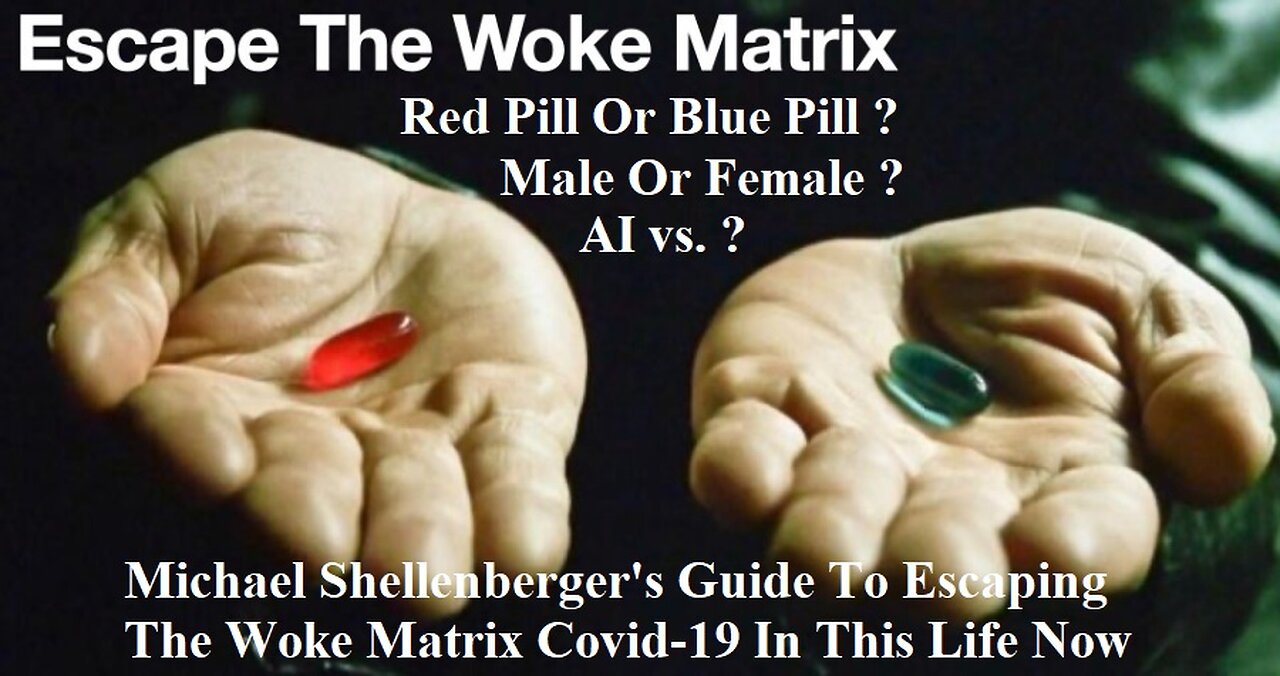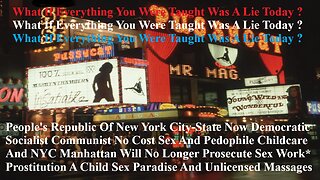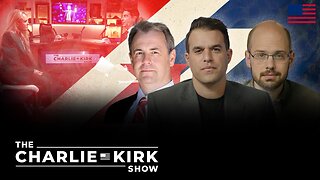Premium Only Content

Michael Shellenberger's Guide To Escaping The Woke Matrix Covid-19 In This Life
Journalist and author Michael Shellenberger argues that wokeism is the dominant religion of elites in the West, complete with guilt, original sin, taboos, saints, devils, and the promise of redemption and immortality. How do we escape the woke matrix? Shellenberger offers a guide. Why Wokeism Will Rule the World. The woke movement could be the next great U.S. cultural export — and it is going to do many other countries some real good.
Escaping the matrix would mean:
1. Escape the cheap dopamine available everywhere on social media
2. Work on self than pleasing others
3. Work, when others are partying , going clubs , getting married
4. Connecting with god and finding your true purpose in life
5. Breaking the norms and traditions society has set for you including getting a degree or job at so and so age. Exploration and networking are the key for discovering where you true self lies
6. You seeking answers from growth related platforms like linkedin , quora to understand life and not watching pleasure seeking reels , short videos etc.
The red pill and blue pill represent a choice between the willingness to learn a potentially unsettling or life-changing truth by taking the red pill or remaining in the contented experience of ordinary reality with the blue pill. The terms originate from the 1999 film The Matrix.
Black pill and white pill
The metaphor of the "black pill" was first popularized by the incel-related blog Omega Virgin Revolt. In this parlance, being red-pilled means believing concepts like male oppression and female hypergamy, while being black-pilled means coming to believe that there is little that low-status or unattractive men can do to improve their prospects for romantic or sexual relationships with women.
This metaphor was extended to political matters, where, after being red-pilled (recognizing, and then rejecting, the dominant political narratives), one can then become either black-pilled (pessimistic or apathetic about the future), or white-pilled (hopeful about the future or believing change is possible.) This metaphor has been embraced by commentators including anarchist Michael Malice, whose 2022 book The White Pill advocates the latter point of view. Malice defines the term as, “It is possible that we will lose, it is impossible that we must lose.”
The matrix includes physicality itself, so any physical action / response is within the matrix. As has been mentioned, you are part of the matrix. Thoughts, ideas, and similar “lofty” things are also part of the simulation. Basically, anything that is derived- or interpreted from experiencing / sensing is part of the matrix.
You can’t get out of such a thing. The wheel of Samsara isn’t optional or surmountable; it’s inevitable. The only thing you can do is see this and surrender to it. This is why it’s called waking up, it’s a realization. You can know that you’re dreaming (waking up), and that there is no alternative (surrender, the mountain is a mountain again).
Note that The Matrix (the movies) are weak single layer models. In reality, waking up is just another dream. Imagine the movie Inception instead, but with no highest / real top level. It’s a flat structure. If you have ever woken up inside a dream before, you might have noticed that there’s no “going deeper” or “higher,” it’s just that the dream continues but from a different place (where you seemed to wake up). If anything happens after the death of this body, that’s what happens.
How do you get to realization? You remove anything that’s in the way of seeing clearly. This includes any idea you have of it; don’t take anyone’s words as gospel. You eliminate all hypotheses and assumptions, with intent and focus, until there are no filters left.
Once no filters are left, what will you see? A rhetorical question. The answer isn’t the point. Getting there is the point, which will render the question obsolete. Good luck.
Ah, escaping The Matrix, an intriguing question indeed! While I can't promise you a red pill or a mind-bending journey like in the movies, let's dive into a friendly, smart, awesome, and slightly amusing response:
Imagine this: You're sitting there, sipping your coffee, when suddenly you realize that reality might not be what it seems. You suspect you're trapped in The Matrix, a simulated world controlled by machines. Well, fear not, dear friend, for I have some suggestions to help you break free!
Embrace Your Inner Neo: Channel your inner hero and become the Neo of your own life. Question everything, challenge the status quo, and seek the truth. Remember, "There is no spoon," so start questioning the spoon-like beliefs that keep you stuck.
Hack Your Mind: Expand your knowledge and sharpen your critical thinking skills. Dive into philosophy, science, and the mysteries of the universe. The more you know, the better equipped you'll be to navigate the rabbit holes of reality.
Unplug from the Digital Abyss: Step away from the screens and take a break from the digital realm. Engage with the world around you, connect with nature, and interact with real people. Break free from the hypnotic grip of social media and rediscover genuine human connections.
Master Your Kung Fu: Okay, maybe not literal Kung Fu, but cultivate your inner strength and resilience. Develop your physical and mental well-being through activities like exercise, meditation, and pursuing your passions. A healthy body and a clear mind can be your allies in facing the challenges of the simulated world.
Rally a Team of Rebel Minds: Remember, you're not alone in this quest. Surround yourself with like-minded individuals who question the status quo and encourage you to break free from the shackles of conformity. Together, you can challenge the system and create your own reality.
Now, my friend, breaking free from The Matrix might not be an easy task, but with curiosity, knowledge, resilience, and a dash of humor, you'll be well on your way to unlocking the secrets of the simulated world. So go forth, embrace the unknown, and may your journey be filled with mind-bending adventures and a touch of Neo's cool leather jacket style! I hope This Helps! Show me some love with an Upvote. Have a wonderful day!
Wokeism Understanding Woke Jargon And Critical Race Theory Words Definition
Understanding Woke Jargon And School Activists employ an array of new words and phrases to describe their beliefs and goals. If you hear many of these phrases and can’t figure out what they mean, that’s because it’s by design. This vocabulary is intended to mislead – to make harmful and extreme ideas sound admirable and to conceal meaning through ambiguity. In preparation for this article I researched several actual glossaries of woke terms. My surprise wasn’t that I found so many to research, rather that the zeal of their collective efforts to fold, bend, staple and mutilate the language of common discourse has remained so resolute despite so much ridicule and parody over the past several years. When SNL, the very embodiment of woke culture, parodies woke culture, it may be time to bid adieu. Still, wokeness refuses to grow old (unlike the rest of us), and therefore requires constant renewal and maintenance (just like the rest of us).*
Admittedly, my modest contribution to the destruction of the language for transparently political reasons is late to the game, although the list below strays somewhat from the traditional glossary format: rather than simply reiterate the intended woke definition of each term or phrase, I define it by its actual Doublespeak counterpart. Please feel free to comment below on my attempts, or add your own…
https://newdiscourses.com/translations-from-the-wokish/
A glossary of terms you need to stay woke in 2023
“That’s what I hate about the times we live in, the terms,” a hapless Ellie Guggenheimer once said, forever immortalized in Tom Wolfe’s “Radical Chic,” a biting ’70s report about upper class society members appropriating street politics. It seems like every time there’s any sort of political pushback on words, there will always be well-meaning people who, struggling to keep up, become averse to society’s new lexicon and the changing times of politics. And of course, these two come hand-in-hand; a large-scale social awakening necessitates a change in language.
By now, it seems obvious that the same thing is happening. When we look back at 2018, there’s one thing that we can say for sure: everyone got a lot more political. Maybe it’s because we have more skin in the game (with dictators and would-be dictators in power, everyone’s rights are in question), or maybe we’ve just evolved as a people. 2018 became the year of power and anger, of visibility and acceptance. LGBTQA+ representation shot up. Victims of sexual abuse and rape, instead of being sent to the lion’s den like they would’ve been in other years, were lionized. The political and social landscape no longer had a place for complacency.
Since the end of the last ice age over 10,000 years ago, the planet has undergone smaller changes in climate. Warming during medieval times and cooling during the “Little Ice Age” a few centuries ago dominated the last millennia. Paleoclimatology puts recent changes in the atmosphere and climate into perspective. The Marcott temperature reconstruction estimated a lot of warming from 15,000 to 7,000 years ago, then a small cooling thereafter, while models simulate a slight warming over the past 7,000 years due to a slow rise in greenhouse gases. For most of the past 10,000 years, global average temperature has remained relatively stable and low compared to earlier hothouse conditions in our planet's history. However, if we totally let it rip, the planet could ultimately be an astonishing 7 degrees Celsius warmer on average and feature seas 52 meters higher than they are now.
What Is Climate Change? Climate change refers to long-term shifts in temperatures and weather patterns. Such shifts can be natural, due to changes in the sun’s activity or large volcanic eruptions. But since the 1800s, human activities have been the main driver of climate change, primarily due to the burning of fossil fuels like coal, oil and gas.
Burning fossil fuels generates greenhouse gas emissions that act like a blanket wrapped around the Earth, trapping the sun’s heat and raising temperatures.
The main greenhouse gases that are causing climate change include carbon dioxide and methane. These come from using gasoline for driving a car or coal for heating a building, for example. Clearing land and cutting down forests can also release carbon dioxide. Agriculture, oil and gas operations are major sources of methane emissions. Energy, industry, transport, buildings, agriculture and land use are among the main sectors causing greenhouse gases.
Humans are responsible for global warming
Climate scientists have showed that humans are responsible for virtually all global heating over the last 200 years. Human activities like the ones mentioned above are causing greenhouse gases that are warming the world faster than at any time in at least the last two thousand years.
The average temperature of the Earth’s surface is now about 1.1°C warmer than it was in the late 1800s (before the industrial revolution) and warmer than at any time in the last 100,000 years. The last decade (2011-2020) was the warmest on record, and each of the last four decades has been warmer than any previous decade since 1850.
Many people think climate change mainly means warmer temperatures. But temperature rise is only the beginning of the story. Because the Earth is a system, where everything is connected, changes in one area can influence changes in all others.
The consequences of climate change now include, among others, intense droughts, water scarcity, severe fires, rising sea levels, flooding, melting polar ice, catastrophic storms and declining biodiversity.
People are experiencing climate change in diverse ways
Climate change can affect our health, ability to grow food, housing, safety and work. Some of us are already more vulnerable to climate impacts, such as people living in small island nations and other developing countries. Conditions like sea-level rise and saltwater intrusion have advanced to the point where whole communities have had to relocate, and protracted droughts are putting people at risk of famine. In the future, the number of “climate refugees” is expected to rise.
Every increase in global warming matters
In a series of UN reports, thousands of scientists and government reviewers agreed that limiting global temperature rise to no more than 1.5°C would help us avoid the worst climate impacts and maintain a livable climate. Yet policies currently in place point to a 2.8°C temperature rise by the end of the century.
The emissions that cause climate change come from every part of the world and affect everyone, but some countries produce much more than others.The seven biggest emitters alone (China, the United States of America, India, the European Union, Indonesia, the Russian Federation, and Brazil) accounted for about half of all global greenhouse gas emissions in 2020.
Everyone must take climate action, but people and countries creating more of the problem have a greater responsibility to act first.
We face a huge challenge but already know many solutions
Many climate change solutions can deliver economic benefits while improving our lives and protecting the environment. We also have global frameworks and agreements to guide progress, such as the Sustainable Development Goals, the UN Framework Convention on Climate Change and the Paris Agreement. Three broad categories of action are: cutting emissions, adapting to climate impacts and financing required adjustments.
Switching energy systems from fossil fuels to renewables like solar or wind will reduce the emissions driving climate change. But we have to act now. While a growing number of countries is committing to net zero emissions by 2050, emissions must be cut in half by 2030 to keep warming below 1.5°C. Achieving this means huge declines in the use of coal, oil and gas: over two-thirds of today’s proven reserves of fossil fuels need to be kept in the ground by 2050 in order to prevent catastrophic levels of climate change.
Adapting to climate consequences protects people, homes, businesses, livelihoods, infrastructure and natural ecosystems. It covers current impacts and those likely in the future. Adaptation will be required everywhere, but must be prioritized now for the most vulnerable people with the fewest resources to cope with climate hazards. The rate of return can be high. Early warning systems for disasters, for instance, save lives and property, and can deliver benefits up to 10 times the initial cost.
We can pay the bill now, or pay dearly in the future
Climate action requires significant financial investments by governments and businesses. But climate inaction is vastly more expensive. One critical step is for industrialized countries to fulfil their commitment to provide $100 billion a year to developing countries so they can adapt and move towards greener economies.
https://www.un.org/en/climatechange/what-is-climate-change
https://climatepromise.undp.org/news-and-stories/climate-dictionary-everyday-guide-climate-change
Confusing Greenland warming vs global warming This argument uses temperatures from the top of the Greenland ice sheet. This data ends in 1855, long before modern global warming began. It also reflects regional Greenland warming, not global warming.
Most of the last 10,000 years were warmer
Even if the warming were as big as the IPCC imagines, it would not be as dangerous as Mr. Brown suggests. After all, recent research suggests that some 9,100 of the past 10,500 years were warmer than the present by up to 3 Celsius degrees: yet here we all are.
This argument is based on the work of Don Easterbrook who relies on temperatures at the top of the Greenland ice sheet as a proxy for global temperatures. That’s a fatal flaw, before we even begin to examine the use of the ice core data. A single regional record cannot stand in for the global record — local variability will be higher than the global, plus we have evidence that Antarctic temperatures swing in the opposite direction to Arctic changes. Richard Alley discussed that in some detail at Dot Earth last year, and it’s well worth reading his comments. Easterbrook, however, is content to ignore someone who has worked in this field, and relies entirely on Greenland data to make his case.
Most of the past 10,000 [years] have been warmer than the present. Figure 4 shows temperatures from the GISP2 Greenland ice core. With the exception of a brief warm period about 8,200 years ago, the entire period from 1,500 to 10,500 years ago was significantly warmer than present.
t’s a graph he’s used before, in various forms, almost certainly copied and altered from the original (click image below to see source: the NOAA web page for Richard Alley’s 2000 paper The Younger Dryas cold interval as viewed from central Greenland, though DE credits it as “Modified from Cuffy and Clow, 1997″, misspelling Kurt Cuffey’s name in the process:
Easterbrook continues:
Another graph of temperatures from the Greenland ice core for the past 10,000 years is shown in Figure 5. It shows essentially the same temperatures as Cuffy and Clow (1997) but with somewhat greater detail. What both of these temperature curves show is that virtually all of the past 10,000 years has been warmer than the present.
Easterbrook plots the temperature data from the GISP2 core, as archived here. Easterbrook defines “present” as the year 2000. However, the GISP2 “present” follows a common paleoclimate convention and is actually 1950. The first data point in the file is at 95 years BP. This would make 95 years BP 1855 — a full 155 years ago, long before any other global temperature record shows any modern warming. In order to make absolutely sure of my dates, I emailed Richard Alley, and he confirmed that the GISP2 “present” is 1950, and that the most recent temperature in the GISP2 series is therefore 1855.
This is Easterbrook’s main sleight of hand. He wants to present a regional proxy for temperature from 155 years ago as somehow indicative of present global temperatures. The depths of his misunderstanding are made clear in a response he gave to a request from the German EIKE forum to clarify why he was representing 1905 (wrongly, in two senses) as the present. Here’s what he had to say:
The contention that the ice core only reaches 1905 is a complete lie (not unusual for AGW people). The top of the core is accurately dated by annual dust layers at 1987. There has been no significant warming from 1987 to the present, so the top of the core is representative of the present day climate in Greenland.
Unfortunately for Don, the first data point in the temperature series he’s relying on is not from the “top of the core”, it’s from layers dated to 1855. The reason is straightforward enough — it takes decades for snow to consolidate into ice.
And so to an interesting question. What has happened to temperatures at the top of Greenland ice sheet since 1855? Jason Box is one of the most prominent scientists working on Greenland and he has a recent paper reconstructing Greenland temperatures for the period 1840-2007 (Box, Jason E., Lei Yang, David H. Bromwich, Le-Sheng Bai, 2009: Greenland Ice Sheet Surface Air Temperature Variability: 1840–2007. J. Climate, 22, 4029–4049. doi: 10.1175/2009JCLI2816.1). He was kind enough to supply me with a temperature reconstruction for the GRIP drilling site — 28 km from GISP2. This is what the annual average temperature record looks like (click for bigger version):
I’ve added lines showing the average temperatures for the 1850s (blue) and the last 10 years (red), and the difference between those is a warming of 1.44ºC. I’ve also added the two most recent GISP2 temperature data points (for 1847 and 1855, red crosses). It’s obvious that the GRIP site is warmer than GISP2 (at Summit Camp). The difference is estimated to be 0.9ºC on the annual average (Box, pers comm). Let’s have ago at reconstructing Easterbrook’s Fig 5, covering the last 10,000 years of GISP2 data.
The GISP2 series — the red line — appears to be identical to Easterbrook’s version. The bottom black line shows his 1855 “present”, and it intersects the red line in the same places as his chart. I’ve added a grey line based on the +1.44ºC quantum calculated from the GRIP temperature data, and two blue crosses, which show the GISP2 site temperatures inferred from adjusted GRIP data for 1855 and 2009.
Two things are immediately apparent. If we make allowance for local warming over the last 155 years, Easterbrook’s claim that “most of the past 10,000 [years] have been warmer than the present” is not true for central Greenland, let alone the global record. It’s also clear that there is a mismatch between the temperature reconstructions and the ice core record. The two blue crosses on the chart show the GISP site temperatures (adjusted from GRIP data) for 1855 and 2009. It’s clear there is a calibration issue between the long term proxy (based on ∂18O measurement) and recent direct measurement of temperatures on the Greenland ice sheet. How that might be resolved is an interesting question, but not directly relevant to the point at issue — which is what Don Easterbrook is trying to show. Here’s his conclusion:
So where do the 1934/1998/2010 warm years rank in the long-term list of warm years? Of the past 10,500 years, 9,100 were warmer than 1934/1998/2010. Thus, regardless of which year ( 1934, 1998, or 2010) turns out to be the warmest of the past century, that year will rank number 9,099 in the long-term list. The climate has been warming slowly since the Little Ice Age (Fig. 5), but it has quite a ways to go yet before reaching the temperature levels that persisted for nearly all of the past 10,500 years. It’s really much to do about nothing.
1855 — Easterbrook’s “present” — was not warmer than 1934, 1998 or 2010 in Greenland, let alone around the world. His claim that 9,100 out of the last 10,500 years were warmer than recent peak years is false, based on a misunderstanding or misrepresentation of data.
The last word goes to Richard Alley, who points out that however interesting the study of past climate may be, it doesn’t help us where we’re heading:
"Whether temperatures have been warmer or colder in the past is largely irrelevant to the impacts of the ongoing warming. If you don’t care about humans and the other species here, global warming may not be all that important; nature has caused warmer and colder times in the past, and life survived. But, those warmer and colder times did not come when there were almost seven billion people living as we do. The best science says that if our warming becomes large, its influences on us will be primarily negative, and the temperature of the Holocene or the Cretaceous has no bearing on that. Furthermore, the existence of warmer and colder times in the past does not remove our fingerprints from the current warming, any more than the existence of natural fires would remove an arsonist’s fingerprints from a can of flammable liquid. If anything, nature has been pushing to cool the climate over the last few decades, but warming has occurred.
Earth’s last ice age ended about 12,000 years ago. The warmer and more stable climate that followed allowed for the development of agriculture and the rise of human civilization. This important period encompassing the past 12,000 years is referred to as the Holocene geological epoch. It also created a “conundrum” for climate scientists, because global temperatures simulated by climate models didn’t match reconstructions from proxy data.
To be specific, the overall temperature change during the Holocene matched pretty well in reconstructions and models, but the pattern didn’t. The best proxy reconstruction from a 2013 paper led by Shaun Marcott estimated more warming than models from 12,000 to 7,000 years ago. Then over the past 7,000 years, Marcott’s reconstruction estimated about 0.5°C cooling while model simulations showed the planet warming by about the same amount.
A new paper led by Jonathan Baker may help to resolve that discrepancy. The scientists examined stalagmites from a cave in the southern Ural Mountains of Russia. The ratio of oxygen isotopes in the stalagmites can be used to estimate past winter temperatures. The Marcott study had one known shortcoming – the proxy temperature data they used mostly represented the summer season. And as Baker explained, changes in the Earth’s orbital cycles have caused cooling in the northern hemisphere summer and winter warming during the Holocene:
Because our orbit is elliptical, we’re not always the same distance from the sun. About 10,000 years ago, Earth was closest to the sun during summer and farthest during winter. Today it is the opposite. Based on this variable alone, we would expect winter warming and summer cooling in the northern hemisphere (and vice versa in the southern hemisphere) over the last 10,000 years.
During the period from 15,000 to 7,000 years ago, temperatures were rising because large ice sheets were disappearing. That was especially true in the summer because back then, the Earth was closest to the sun during that season. So the Marcott temperature reconstruction, which was predominantly based on summer temperature proxies, estimated a lot of warming from 15,000 to 7,000 years ago (more than in model simulations), then a small cooling thereafter, while models simulate a slight warming over the past 7,000 years due to a slow rise in greenhouse gases.
The stalagmite data in the Baker study show that winter temperatures behaved differently and can reconcile the discrepancies between the Marcott reconstruction and model simulations. This suggests that the climate models are right – Earth’s surface temperature warmed rapidly at the end of the last ice age, from about 17,000 to 7,000 years ago, then the rate of warming slowed as the climate stabilized. However, it didn’t reverse into a cooling trend, because atmospheric greenhouse gas levels were rising.
Then of course came the Industrial Revolution 200 years ago, and carbon dioxide levels consequently shot up due to humans burning fossil fuels. As a result, temperatures have spiked as well. Over the past 130 years, global surface temperatures have risen about 20 times faster than when the Earth transitioned out of the last ice age. Over the past 40 years, the rate of global warming has been 3 times faster yet.
And that’s in comparison to Earth’s fastest natural climate change, when it’s transitioning from an ice age to a warm period. Over the past 7,000 years, when human civilization was able to develop and thrive, Earth’s temperatures and climate were quite stable. The temperature change during the past 7,000 years was about 0.5°C. Humans have caused that much warming in just the past 25 years. If we follow through with the Paris agreement and manage to limit global warming to 2°C over a 200-year period, in that best-case scenario the Earth would still warm 20 times faster than a natural ice age transition. If we fail to cut carbon pollution, that rate could speed to more than 50 times faster than Earth’s fastest natural climate change.
There are several important points we can take from the Baker study. First, climate models are able to simulate climate changes over the history of human civilization fairly accurately. Second, when there’s a discrepancy between data and models, people have a tendency to distrust the models, but sometimes the problem lies more in the data. Third, if not for the human influence, the climate would continue the stable conditions of the past 7,000 years, during which time human civilization developed and thrived.
Fourth and most importantly, humans are in the process of destabilizing the climate, and we’re already causing global warming at a rate 20 times faster than Earth’s fastest natural climate change. That’s why climate scientists are so concerned, and why the Paris agreement is so important.
Coronavirus, Climate Change, and the Environment
A Conversation on COVID-19 with Dr. Aaron Bernstein, Former Director of Harvard Chan C-CHANGE
Below are some of the most common questions we have been receiving in relation to the environment and coronavirus 2019 (COVID-19).
This page will continue to be updated as new information arises. If you would like to talk to someone at our center about coronavirus, please email us at [email protected].
For the latest updates, guidance, useful information, and resources about COVID-19 from the Harvard Chan Community, click here.
QUESTIONS:
Does climate change affect the transmission of coronavirus?
Does air pollution increase the risk of getting coronavirus? Does it make symptoms worse?
Will warmer weather slow the spread of coronavirus?
How likely are we to see infectious disease spread as a result of climate change?
Why are emerging infectious diseases on the rise?
What actions can we take to prevent future outbreaks?
Can you identify the communities most at-risk, and how and why both COVID-19 and climate change harms them?
Why is it so important for health officials to talk about climate change now?
Climate change and global health policy are largely treated as separate issues by the public and media. Do we need to adjust our thinking?
COVID-19 is killing people now and climate change is killing people now. The scale of actions to combat them are starkly different. Why?
Is climate change too expensive to fix?
Does climate change affect the transmission of coronavirus?
We don’t have direct evidence that climate change is influencing the spread of COVID-19, but we do know that climate change alters how we relate to other species on Earth and that matters to our health and our risk for infections.
As the planet heats up, animals big and small, on land and in the sea, are headed to the poles to get out of the heat. That means animals are coming into contact with other animals they normally wouldn’t, and that creates an opportunity for pathogens to get into new hosts.
Many of the root causes of climate change also increase the risk of pandemics. Deforestation, which occurs mostly for agricultural purposes, is the largest cause of habitat loss worldwide. Loss of habitat forces animals to migrate and potentially contact other animals or people and share germs. Large livestock farms can also serve as a source for spillover of infections from animals to people. Less demand for animal meat and more sustainable animal husbandry could decrease emerging infectious disease risk and lower greenhouse gas emissions.
We have many reasons to take climate action to improve our health and reducing risks for infectious disease emergence is one of them.
Does air pollution increase the risk of getting coronavirus? Does it make symptoms worse?
Recent research from Rachel Nethery, Xiauo Wu, Francesca Dominici and other colleagues at Harvard Chan has found that people who live in places with poor air quality are more likely to die from COVID-19 even when accounting for other factors that may influence risk of death such as pre-existing medical conditions, socioeconomic status, and access to healthcare.
This finding is consistent with prior research that has shown that people who are exposed to more air pollution and who smoke fare worse with respiratory infections than those who are breathing cleaner air, and who don’t smoke.
In places where air pollution is a routine problem, we have to pay particular attention to individuals who may be more exposed or vulnerable than others to polluted air, such as the homeless, those who don’t have air filtration in their homes, or those whose health is already compromised. These individuals may need more attention and support than they did even before coronavirus came along.
For those interested in research papers on air pollution and virus transmission:
Exposure to air pollution and COVID-19 mortality in the United States (Harvard University, preprint, 2019). This study found that a small increase in long-term exposure to PM2.5 leads to a large increase in COVID-19 death rate.
Measuring the impact of air pollution on respiratory infection risk in China (Environmental Pollution, 2018). This study found that worse air quality in China may increase transmission of infections that cause influenza-like illnesses.
The association between respiratory infection and air pollution in the setting of air quality policy and economic change (Annals of the American Thoracic Society, 2019). A study of nearly 500,000 New York residents found that higher particulate matter air pollution levels increased the chances of hospitalization for pneumonia and emergency deparment visits, especially for influenza.
Airborne transmission may have played a role in the spread of 2015 highly pathogenic avian influenza outbreaks in the United States (Scientific Reports, 2019). Researchers have found that several viruses, including adenovirus and influenza virus, can be carried on air particles. This recent paper finds that particulate matter likely contributed to the spread of the 2015 avian influenza.
Relationship between ambient air pollution and daily mortality of SARS in Beijing (Biomedical and Environmental Sciences, 2005). During the SARS epidemic in 2003, this study found that increases in particulate matter air pollution increased risks of dying from the disease. SARS is a coronavirus, like COVID-19.
Will warmer weather slow the spread of coronavirus?
We don’t yet have a sense of what the changing weather will mean for COVID-19 and so we shouldn’t rely upon warmer weather to curtail transmissions. We need to do everything we can right now to slow the spread of this disease, and that means we need to follow the advice that public health experts are telling us and practice social distancing and good hand hygiene, among other actions.
How likely are we to see infectious disease spread as a result of climate change?
Climate change has already made conditions more favorable to the spread of some infectious diseases, including Lyme disease, waterborne diseases such as Vibrio parahaemolyticus which causes vomiting and diarrhea, and mosquito-borne diseases such as malaria and dengue fever. Future risks are not easy to foretell, but climate change hits hard on several fronts that matter to when and where pathogens appear, including temperature and rainfall patterns. To help limit the risk of infectious diseases, we should do all we can to vastly reduce greenhouse gas emissions and limit global warming to 1.5 degrees.
Why are emerging infectious diseases on the rise?
We have seen a trend of greater emergence of infectious diseases in recent decades. Most of these diseases have entered into people from animals, especially wild animals. This trend has many causes. We have massive concentrations of domesticated animals around the world, some of which can be home to pathogens, like the flu, that can make people sick. We also have massive concentrations of people in cities where diseases transmitted by sneezing may find fertile ground. And we have the ability to travel around the globe in less than a day and share germs widely.
But a look at the origins of COVID reveals that other forces may be in play. In the past century we have escalated our demands upon nature, such that today, we are losing species at a rate unknown since the dinosaurs, along with half of life on earth, went extinct 65 million years ago. This rapid dismantling of life on earth owes primarily to habitat loss, which occurs mostly from growing crops and raising livestock for people. With fewer places to live and fewer food sources to feed on, animals find food and shelter where people are, and that can lead to disease spread.
Another major cause of species loss is climate change, which can also change where animals and plants live and affect where diseases may occur. Historically, we have grown as a species in partnership with the plants and animals we live with. So, when we change the rules of the game by drastically changing the climate and life on earth, we have to expect that it will affect our health.
What actions can we take to prevent future outbreaks?
We can make many smart investments to avert another outbreak. Federal, state, and local agencies can support public health leadership and science, we can provide more funding for needed research, early response to outbreaks, and supplies for testing. And we can do much more to control the illegal wildlife trade.
We also need to take climate action to prevent the next pandemic. For example, preventing deforestation—a root cause of climate change—can help stem biodiversity loss as well as slow animal migrations that can increase risk of infectious disease spread. The recent Ebola epidemic in West Africa probably occurred in part because bats, which carried the disease, had been forced to move into new habitats because the forests they used to live in had been cut down to grow palm oil trees.
Rethinking our agricultural practices, including those that rely on raising tens of millions of animals in close quarters, can prevent transmissions between animals and spillover into human populations.
Reducing air pollution caused by burning fossil fuels like coal, oil and natural gas also helps keep our lungs healthy, which can protect us from respiratory infections like coronavirus.
To combat climate change, we need to drastically decrease greenhouse gas emissions. Generating electricity from low-carbon energy sources like wind and solar decreases harmful air pollutants such as nitrogen oxides, sulfur dioxide, and carbon dioxide that lead to more heart attacks and stroke as well as obesity, diabetes, and premature deaths that put further strains on our health care systems.
Preparation for pandemics is also about keeping people healthy at baseline. If we have a population in the U.S. where a third of our population are obese, and 5-10% of people have diabetes, we’re going to be immensely more vulnerable. And if you look at why people in the U.S. are not healthy at baseline, it has to do with our diets, pollution, and climate change. We have an opportunity here to recognize that prevention is by far the best approach to protecting health.
When COVID-19 eases, and we are ready to restart our economy, we can make our workforce healthier and more climate-resilient through scaling-up our investments in low-carbon technologies.
Can you identify the communities most at-risk, and how and why both COVID-19 and climate change harms them?
People with chronic health conditions, lower-income, and communities of color are disproportionately impacted by both COVID-19 and climate change, and pollution is at the heart of both problems as a new Harvard T.H. Chan School of Public health study confirms. We know that African American communities are disproportionately exposed to air pollution and we’re now seeing this pollution driving higher mortality rates from COVID-19. We owe it to everyone to improve health, and we do that by reducing the sources of pollution that drive a large burden of disease both in the United States and around the world.
Why is it so important for health officials to talk about climate change now?
Having taken care of children and families who are deeply concerned about how they can protect their children from this disease, I can tell you that we need to wash our hands and we need to socially distance. But if we really care about preventing this kind of problem in the future, we need to think hard about climate change and the biodiversity crisis. I was actually in a room with a child and a family when I first thought that this is exactly the time that we need to think more about the broader issues that we face. We simply cannot afford to deal with a crisis like this pandemic on top of another climate-related crisis—like a hurricane, tornado, wildfire, or heatwave—when we absolutely know how to implement climate solutions, and can put them into action right now. Doing so will make us healthier today and protect our future.
Climate change and global health policy are largely treated as separate issues by the public and media. Do we need to adjust our thinking?
Yes. The separation of health and environmental policy is a dangerous delusion. Our health entirely depends on the climate and the other organisms we share the planet with. We need to bring these communities together. Some progress has been made in addressing the risk of pathogen spillover from animals into people. But largely we still view the environment, and life on earth, as separate. We can and must do better if we want to prevent the next infectious pandemic. That means we must combat climate change and do far more to safeguard the diversity of life on earth, which is being lost at a rate not seen since the dinosaurs—and more than half of life on earth—went extinct 65 million years ago.
COVID-19 is killing people now and climate change is killing people now. The scale of actions to combat them are starkly different. Why?
Infectious diseases are scary because they are immediate and personal. They radically and rapidly change how we lead our lives, and they are an immediate threat to our friends and families. They hit all of our “go” buttons.
Climate change seems to many an armageddon in slow motion and its dangers can feel impersonal and its causes diffuse. It’s easy to think “I didn’t cause this” or that “it doesn’t directly affect me.” But there’s another way to look at it. Like COVID-19, if you’re concerned about climate change, you can take actions right now to improve your health and the health of your friends and loved ones.
We can learn from this pandemic that people are motivated by the personal and the actionable. At Harvard Chan C-CHANGE, our research shows that the actions we need to combat climate change are the same actions we need to make people healthier right now, especially for diseases causing huge burdens on our health like obesity, heart disease, and cancer. We need to do much more to talk about the “burden of disease” that’s preventable, and the things we can do now to prevent it.
Is climate change too expensive to fix?
We spend just over $3 trillion every year in the United States on health care. And by some estimates, more than half the deaths in the United States are preventable, largely because of pollution, diet, exercise, and lifestyle habits like smoking. So think about the money we could save simply by reducing air pollution, eating less meat, and building exercise into our day by walking or biking more often. We could use the savings to invest in preventing climate change, among other things like education, and paying fair wages.
When you look at this question purely from a financial standpoint, air pollution is a drag on economic growth and solutions to address have been enormously cost-effective in the United States. In 2011, a study by the Environmental Protection Agency that looked at the costs and benefits of the Clean Air act found that every $1 invested to reduce air pollution returns up to $30 in benefits. The only thing our health and our economy can’t afford is climate inaction.
https://diversity.social/wokeism-woke-culture/
WOKEISM – THE NEW RELIGION OF THE WEST There is a new religion. It is moving like a tidal wave through every facet of western culture, shaping and redefining society as it goes. This religion masquerades under the guise of compassion and justice, but underneath is an evil ideology that is incompatible with western values and incongruent with the Christian worldview. This movement did not start in Minneapolis on May 25th, when George Floyd was murdered. That event acted as a watershed moment for an ideology that has been growing for decades. If left unchecked, this new religion could lead to a complete unravelling of western culture.
There are many names for what we currently find ourselves in; wokeness, political correctness, and cancel culture are some of them, but these only encapsulate a portion of the phenomenon. Cultural Marxism, neo-marxism, social justice, identity politics, and Critical Theory are broader descriptors. We would like to use a term that adequately captures the religiosity of the movement: wokeism.
Wokeism is a religion. Although it has not been organized into any formal religious structure, it has all the functions of religious doctrine. It has a unique epistemology (theory of knowledge), an evaluation of the human condition, and a redemption narrative. But from where did it come?
CRITICAL THEORY
In the early 20th century, a German school of philosophy called the Frankfurt School developed a social philosophy called Critical Theory. In a nutshell, Critical Theory critiques culture and challenges the underlying power structures of society. It is a movement to “liberate human beings from the circumstances that enslave them,” reinterpreting western culture as a story of the oppressor vs. oppressed. In Critical Theory, the only things that exist are hierarchies of power, and those hierarchies must be torn down. The goal of this movement, whether stated or not, is nothing less than the complete dismantling and rebuilding of western culture from the ground up.
Critical Theory started to become prominent among western academics in the 90s and eventually infiltrated almost every university in the western world. In recent years, the ideology has left the university and has made the jump to media and corporate culture, establishing itself as the primary moral culture within western societies. Currently, the main lines of separation between oppressors and oppressed are race, sex and gender identity.
This is not just a political or social movement within the framework of traditional enlightenment values. Concepts such as logic, science, and reason are viewed as tools of the oppressive white patriarchy. Values like individualism, hard work, punctuality and delayed gratification would be understood as perpetuating white supremacy. Critical Theory has become much more than a social philosophy and is the primary philosophical driving force behind the new civil religion of wokeism.
The goal of this movement, whether stated or not, is nothing less than the complete dismantling and rebuilding of western culture from the ground up. THE NEW RELIGION
Why call wokeism a new religion? The fact is that the rise of secular humanism over the past 70 years created a religion-shaped hole in our culture. Secularism, for all of its cultural dominance, failed to offer a robust philosophy of meaning and purpose, nor did it provide any moral framework for how to act within the world besides “be a good person because the alternative is undesirable for everyone.” Alternatively, wokeism has developed its view of reality with its own set of values and narratives. From the ashes of secular humanism, a new civil religion rises.
Wokeism offers everything that secularism failed to provide, and has quickly filled the God-shaped hole in our culture. It purports its version of truth, justice, righteousness, sin, and judgement. It provides its adherents meaning, with its meta-narrative of societal conflict, power struggle and the struggle for redemptive freedom. The tearing down those oppressive power structures helps give purpose to the individual and the collective. These values are solidified in public rituals like sensitivity training or confronting white fragility. There is a strong communal aspect, and people feel like they are part of something greater than themselves. Also inherent in this “social progress” is the hypothetical future utopian society liberated from the evils of the current oppressive system. Most of all, however, Wokeism offers what every sinful human heart deeply longs for, and that is moral justification. People believe they are acting justly within the world, and being fair, sometimes they are. But often, all that they are doing is mere posturing, or worse, destructive.
That is not to say the Wokesim offers total absolution to its followers; in fact, it is quite the opposite. To be tearing down oppressive power structures means that you are also profoundly aware of your prejudices. James Lindsay, a mathematician, academic, and atheist, was recently on Joe Rogan and said:
“Some religions look up, they’re looking at God, and they’re afraid of sin, but they’re paying attention to God, and they’re thinking about renewal, they’re thinking about redemption, they’re thinking about forgiveness. And then some religions look down, and all they do is look at sin. If you look up, then religion can be great, it can lead people in spiritual development, community and so on, but if you’re looking down, if you’re obsessing about sin, you’re going to start obsessing about everybody else’s sin too.”
The ideas of sin (privilege) righteousness (victimhood) and damnation (cancellation) are well established within Wokeism. While it provides rituals of penance (“check your privilege” and “allyship”) and piety (kneeling during the anthem or posting black squares), what it never offers is forgiveness. In a recent interview with Dave Rubin, theologian Nathan Finochio described the phenomenon:
“If I’m stuck in the oppressor group and there’s no escaping it, there can be no forgiveness if there’s no repentance, right? Like, isn’t that how it works? So I’m just perpetually a sinner, and I’m just going to continue to perpetuate the oppressor group, and there’s nothing that I can do. Of course, cancel culture is actually the logical conclusion of Critical Theory…because they have to get rid of the oppressor class.”
DIFFERENCES WITH CHRISTIANITY
What’s so nefarious about Wokeism is that it regularly plays on people’s better motivations such as compassion and a desire for justice. Most people have a genuine desire to see the lives of others improve, and many Christians have engaged with these ideas as if they are congruent with the teachings of Christ. Of course, there are disparities in our society where justice is needed. Still, the point is that Wokeism has different interpretations for the concepts of truth, justice and equity and leaves no room in the conversation for alternative ways of addressing those issues. Wokeism is incompatible with the biblical worldview, differing in several key ways. First, it attributes intrinsic guilt or innocence to the individual based on their group identity, regardless of individual actions.
Proverbs 17:15
He who justifies the wicked and he who condemns the righteous
are both alike an abomination to the Lord.
The belief at the core of western culture is that each individual is made in God’s image and is therefore intrinsically worthy of dignity and respect. This idea sits at the foundation of our legal system as well. In the biblical moral framework, the individual is responsible to God for his or her actions. The notion that sin or righteousness could be inherited based on one’s natural identifiers, like race, gender, or descent, was refuted when the Lord spoke to the prophet Ezekiel.
Ezekiel 18:1-3
The word of the Lord came to me: “What do you mean by repeating this proverb concerning the land of Israel, ‘The fathers have eaten sour grapes, and the children’s teeth are set on edge’? As I live, declares the Lord God, this proverb shall no more be used by you in Israel. Behold, all souls are mine; the soul of the father as well as the soul of the son is mine: the soul who sins shall die.
The New Testament takes it a step further, saying that “From now on, therefore, we regard no one according to the flesh.” (2 Corinthians 5:16) As followers of Jesus, we are not to judge people based on natural identifiers (race, age, sex, etc.); instead, we are to evaluate them based on the moral standards of the scriptures and treat them as equals, created by God.
Second, the narrative of redemption that Wokeism puts forward is entirely antithetical to the Christian narrative. The biblical stories present the pattern of the individual, in relationship with God, as the primary mechanism for the redemption of the world. This pattern culminates with Christ as the perfect man and sacrifice for the sins of the world. Our belief in his finished work and submission to his Lordship is our motivation to act justly within the world. Therefore, the ideal Christian behaviour is one of mercy, peace, kindness, and forgiveness.
Wokeism, on the other hand, presents the redemptive pattern of various groups vying for power within an inherently oppressive system. In this tribalistic vision of the world, the only thing that exists is power, and if only power exists, then power and control are necessary to tear down a corrupt system. In this narrative of redemption, violence is easily justified. For this reason, we have seen violent riots and not just peaceful protests sweeping America over the past two months.
In this tribalistic vision of the world, the only thing that exists is power, and if only power exists, then power and control are necessary to tear down a corrupt system. POSSIBLE FUTURES
Western culture has already reached its tipping point. Critical Theory has become the mainstream social philosophy, and Wokeism has become the new civil religion. There are two conceivable ways that our future will unfold. The first is that Wokeism will eat itself and dissolve because these ideologies are inherently self-consuming. If the only thing that exists is power, then corrupt power structures must be torn down. It could be that enough people will begin to wake up to the cognitive dissonance that is being shoved down our collective throats, but that is an incredibly optimistic view of the current situation.
What’s more likely is the second option; that these ideas will be taken to their logical conclusion. In the interview mentioned above, Nathan Finochio said that “cancel culture is actually the logical conclusion of Critical Theory… because they have to get rid of the oppressor class.” Rubin responded with the following.
“I hate to tell you I think it’s beheading that is the logical conclusion of cancel culture.”
We have already seen an autonomous zone called CHOP (named after the French Revolution) and a guillotine in front of Jeff Bezos’s house. People seem to think that something like “The Great Leap Forward” couldn’t happen in the western world, but it’s precisely this assumption that could be our undoing.
HOW DO WE RESPOND?
Bradley Campbell recently wrote an article for Quillette, saying:
“However it plays out, those who have problems with the new culture, or with aspects of it, aren’t going to get anywhere simply by dismissing it or mocking it. To the extent that social justice culture offers a new moral vision, they’ll need to offer an alternative moral vision.”
As Christians, we must be the ones to offer this “alternative moral vision,” namely, the Gospel of Jesus Christ. We cannot incorporate Critical Theory into the Gospel. The mixture of these two ideologies will only result in Church fracture, the loss of brotherly love, and the perversion of the Gospel. Unfortunately, many believers have already integrated these doctrines into their theology. The trojan horse of Wokeism has entered the Church. Time will tell how the Church responds.
Again, all this is not to say that we shouldn’t care about issues of justice or socioeconomic disparity. Black lives do matter. Just law enforcement policies are important. Poverty should be alleviated. These issues deeply matter to the heart of God, and we need to be seeking God’s solution to address the roots of the problems. But God has already put forward his definitions of sin and righteousness, justice and redemption. His interpretations are the ones that matter, and his meta-narrative is the one that we are actually living in. It’s up to the Church to identify the lies of the enemy, speak the truth in love, and seek the solutions that come from heaven. Perhaps it’s not too late.
Isaiah 5:20-21 Woe to those who call evil good and good evil, who put darkness for light and light for darkness, who put bitter for sweet and sweet for bitter. Woe to those who are wise in their own eyes and clever in their own sight.
https://en.wikipedia.org/wiki/Woke
Wokeism: What Does It Mean, Why Is It Important, And Why We Need To Support It. In-depth review to understand the Woke Culture, why we need to support wokeism, and how we can support the woke culture.
Wokeism is a term used to describe a social and political movement that seeks to address and correct social injustices, inequality, and discrimination. It emphasizes recognizing and challenging systemic issues, like racism, sexism, and other forms of oppression. The movement is associated with promoting empathy, inclusivity, and awareness of diverse perspectives.
“Wokeism” is a term derived from the African American Vernacular English (AAVE) expression “stay woke,” which means to remain aware and vigilant of social and political issues. It has since evolved to describe a broader social and political movement advocating for social justice, equality, and the dismantling of systemic discrimination. The origins of Wokeism can be traced back to the Civil Rights Movement, but it has gained significant momentum in recent years.
“Woke” or “wokeness” is a term used to describe a way of thinking that focuses on being aware of and fighting against social injustices. It’s like being aware that not everyone is treated fairly in our society, and trying to do something about it.
It’s important to note that “wokeism” is not an official term or organization, but rather a concept that has gained
For example, if you notice that someone is being treated unfairly because of their skin color, being “woke” means speaking up and doing something to help them. It’s like being a superhero who fights for what’s right and fair!
Some people might not like the idea of wokeness because they don’t think there’s a problem with how things are. But being aware of and fighting against unfairness is an important part of making our world a better place for everyone.
Introduction
The present era sees an ever-increasing awareness of social issues; people today are more sensitive toward injustice, discrimination, and all types of prejudice. We are more willing to fight those things than at any other time in our history.
The fight for social justice, equal rights, and equal opportunity can fall into several frameworks from which most of us operate. Through these frameworks and prisms, we can understand the fundamental problems and issues, understand what is at stake, and employ better strategies to fight for a better future.
Among those strategies, wokeism is probably one of the more prominent today due to some reasons. It is employed by those who belong to the younger strata of society, one that is very culturally aware and aware of social issues mainly due to available technologies that allow them to read about vital concerns of the day.
They are also the most active social media users, serving as a virtual platform in our fight against injustice, intolerance, and discrimination. “Wokes” can participate in the discussion and exchange ideas about the day’s issues, making them even more aware and educated.
But what is Woke Culture exactly, and why is it essential that we become aware of it? How does it help us understand different cultures and our fight for social justice, tolerance, and equality?
What is Woke Culture?
Wokeism is a term derived from the word “woke,” which initially meant being aware of social and political issues, particularly around race and injustice. The concept of Wokeism has expanded to encompass a broader range of social issues such as gender, sexuality, and environmental concerns.
What does it mean to be woke? First used in the 1930s, it was part of the lexicon of the American left, but now primarily refers to the millennial generation active in discussing some social issues.
Unity in Diversity
The usual woke definition is that of a person who exhibits attitudes and behavior keenly “sensitive to political and social injustice.” That may be an extensive definition, so it is better to narrow down some of its aspects.
What are the political and social injustices being talked about here? It can be everything that we fought against in the last century or two. Political oppression, such as denial of political rights and civil liberties to other people, including, but not limited to, free speech, freedom of expression, voting, and rights to education, and others.
We are fighting against racial injustice and all forms of racial discrimination, including but not limited to racial inequality. Fighting against denial of rights, and fighting discrimination against a particular race, color, or ethnicity.
Fighting for gender equality, which includes, but again, is not limited to fighting for gender inclusivity in society, such as in work and education; fighting for greater rights. Fighting against gender discrimination in all of its forms, and promoting equal representation in work, media, and others.
Wokes fight injustice concerning those issues but are not limited to it. But how do the wokes exhibit those attitudes and behavior? In short, what do the wokes do to qualify them as such?
The defining behavior of those belonging to Woke Culture is that they are active participants in the fight against injustice. Wokes are not just passive observers of what is happening. They make their mark and manifest their agreement or disagreement concerning particular acts, especially those many deem unjust.
Due to the prevalence of technology and social media, the expression of political acts is now broader. Whereas before, people expressed their fight against injustice through various political acts such as voting or rallies, today, it is now possible to express it through various social media platforms.
They express their attitudes on social media, commenting on issues and adding their voices to those promoting the fight for justice or condemning the social and political injustice today. By showing solidarity with others, they show the world that those fighting injustice can rely on real numbers and people.
But these are for preliminaries. They express solidarity by joining protests and marches when push comes to shove. That, again, is in condemnation of particular injustice or support of a particular policy promoting equality and social justice.
But support is not limited to these activities. They show solidarity with individuals promoting social justice causes by propagating the message of justice, social equality, and equal rights and protection for all.
Going back to woke definition, we can describe it as the culture of active participation in disseminating discourse meant to fight all forms of political, racial, and gender oppression, and diversity. Of course, the ultimate goal is to promote social justice, equal rights, and better protection against formerly discriminated groups.
Gender Pay Gap: In 2020, women earned 84 cents for every dollar earned by men, a 16% pay gap (Source: Pew Research Center). Wokeism aims to raise awareness about such inequalities and advocate for equal pay for equal work.
Racial Inequality: People of color are more likely to experience poverty in the United States. In 2020, 19.5% of Black individuals and 17.0% of Hispanic individuals lived in poverty, compared to 7.7% of non-Hispanic white individuals (Source: U.S. Census Bureau). Wokeism seeks to address these disparities and support policies that reduce poverty and promote economic opportunity for all.
LGBTQ+ Rights: In a 2020 study, 86% of LGBTQ+ students reported experiencing verbal harassment at school due to their sexual orientation or gender identity (Source: GLSEN National School Climate Survey). Wokeism aims to create a more inclusive and accepting environment for LGBTQ+ individuals by promoting education and understanding around these issues.
Victim Rights Movement in the United States.
https://www.ncjrs.gov/ovc_archives/ncvrw/2005/pdf/historyofcrime.pdf
https://www.ncjrs.gov/ovc_archives/ncvrw/2005/pg4b.html
Since then, victim rights and services have become institutionalized in laws and professional practice in the fields of law enforcement, medicine, social services, law, and victim advocacy.
-
 3:00
3:00
What If Everything You Were Taught Was A Lie?
1 day agoPeople's Republic Of New York City-State Now A Democratic-Socialist-Communist No Cost Sex Work
1.07K -
 15:39
15:39
Megyn Kelly
2 hours agoTucker Carlson on Why He Interviewed Nick Fuentes and What He Wanted to Convey To Him
2.3K18 -
 LIVE
LIVE
Kim Iversen
2 hours agoZionists PANIC Over Muslim Mayor In NYC
3,978 watching -

Redacted News
2 hours agoBREAKING! Trump Makes HUGE Announcement Trying To Save MAGA, Cost of Living & Israel CRUSHED GOP
73.4K111 -
 LIVE
LIVE
Dr Disrespect
7 hours ago🔴LIVE - DR DISRESPECT - ARC RAIDERS - QUEST MASTER
1,672 watching -
 2:17:37
2:17:37
The Quartering
4 hours agoFooled Again! Mamdani Backtracks Everything & Today's Breaking News!
173K71 -
 1:17:04
1:17:04
DeVory Darkins
5 hours agoPelosi SURRENDERS announces retirement and Bernie Sanders makes stunning admission
92.3K105 -
 DVR
DVR
StoneMountain64
5 hours agoArc Raiders is actually INCREDIBLE
49.8K2 -
 LIVE
LIVE
FusedAegisTV
6 hours agoFUSEDAEGIS PLAYS THE GREATEST JRPG EVER MADE ⌛► CHRONO TRIGGER (1995) Part 4
106 watching -
 1:57:50
1:57:50
The Charlie Kirk Show
6 hours agoErika's Interview + Auburn Aftermath | Schlichter, Lomez | 11.6.2025
101K19